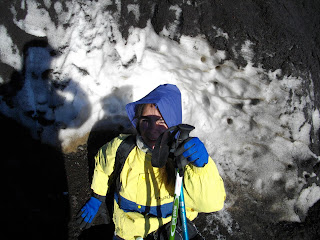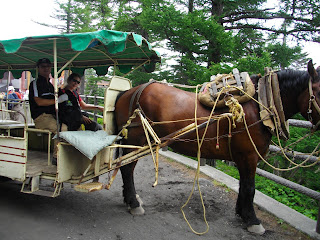
Dolphin Island is probably one of the most beautiful islands I've ever visited. Besides the small but pristine and completely empty beach where you can swim and snorkel, there was a dolphin show, a sea lion show, and a chair lift up a mountain, offering a spectacular view of the bay. No videos here, unfortunately; I ran out of memory. But here's a picture of me touching the dolphins. Usually they charge to pet the dolphins and you have to sign up for a slot, but there's a tank where the dolphins just hang out before and after shows and petting times, and I figured I could touch one for free. I did what I've seen trainers in shows do: flattened my hand and kept it still over the water. Sure enough, the dolphin jumped up and touched my hand!

Mom was shocked, but I explained it was just part of their training. They see human hands in certain positions as "pointers." If they touch them, they get fish. That explains why after the fifth time I did that and still gave the dolphin no fish, it tried to bite me! It wasn't happy with me taking advantage of it's conditioning.
The sea lion was REALLY amazing. She could do all sorts of tricks I'd never seen before; acrobatics almost. But if you want to see it, you'll just have to go there yourself!
Here's the lift take takes you up to the top:

And here's the view:


We walked all the way around the island, then hopped on another boat to take us to Mikimoto Pearl Island, the birthplace of cultured pearls. There's a whole process to it, you know! They have to implant part of a fresh water oyster shell into the gonads (sexual organ) of a salt water oyster, attach part of another oyster's mantel to the fresh water implant, and then wait four years! Taking care of the oysters during that time is also difficult; they must be moved frequently to avoid typhoons and water that is too hot or too cold. Only 1/3 of oysters survive, and of those, only 1/4 make a marketable pearl, and only 1/10 of those are actually of high quality! It's a hard industry! We also saw many beautiful works of art made from pearls, from crowns to globes to hairpins to anything imaginable. They were all so beautiful and lustrous, but no pictures allowed, of course.
But the best part was getting to see the famous ama women divers. In Japan diving is an occupation typically reserved for women since ancient times, because it is believed women have a larger lung capacity. They dive for oysters, sea weed, urchins, and all manner of other sea food and products without any oxygen or diving equipment. Instead, they use a special kind of breathing control, whistling when they surface. It's a really unique sound, one of the hundred famous "sound scapes" of Japan. The average age of the Ama now is about 72! So unfortunately, they are dying out. Here's an ama coming up with an oyster:

Toba is famous for it's seafood, so of course we had to have some for dinner (well, I had seafood, Mom ate pork). The giant shrimp (Ise ebi) was really good, but as with most oysters in Japan, those were pretty gross. They're bred for pearls, not meat. They taste bitter and sandy rather than sweet and tender like ones from the U.S.
We wanted to watch the sunset over the bay, but unfortunately it was really cloudy, so even after we climbed up a mountain, there wasn't anything to see. Oh, well, I'll just have to go back! I want to see the famous Toba aquarium, wedded rocks, and take the Ago bay cruise.
The following day, I had to go to school, so Mom watched the koto (Japanese thirteen-stringed harp)club practice while I did my paper work for upcoming camps and such. Our koto club is famous, number one in Mie prefecture. They practice three hours every day without a break, and then in the summer they practice another three hours after that, so six hours a day in the summer! And that's not including individual practice time. After Mom watched them, she went home and rested. That evening I took her grocery shopping and to the pet store. She really liked seeing the different kinds of animals for sale, and what a traditional Japanese grocery stores looks like. Very different! We had crapes for a snack, and for dinner, my Wednesday night class picked us up! It was a potluck at my Ojiichan's (Japanese Grandpa's) house, so everyone brought something and Mom got to sample more Japanese home cooking. She also got a chance to try out Ojichan's koto, and to play his piano for them. They really liked her and asked her to come back anytime!
Thursday we went to Ise Grand Shrine, the most important Shinto shrine in all of Japan. It supposedly enshrines the sun goddess, the most important of all Japanese Shinto gods, and founder of the Imperial line (the Emperor was once said to be her descendant). I really don't have anything exciting to report about that. It poured for an hour, followed by extreme sweltering heat. I don't really like shrines much, but I suppose if you go to any shrine in Japan, that's number one, so go there. Japanese Shinto shrines are not very decorative or ancient-looking, since they rebuild them entirely out of plain, unpainted wood every thirty years or so, cutting down most of the surrounding forests in the process. We saw the sacred roosters and the sacred koi and the giant tori (bird) gate that is supposed to be where the sacred roosters roost, but none of them can fly up that high. Here's that, along with the really famous, long bridge leading into the shrine:

And here's the place were you buy relics and charms and stuff:

And a giant, sacred tree:

There's also the nearby shopping village, which is a great place to get decently priced traditional sweets and arts and crafts such as pottery, fans, clothes, and the like. Even if you're not into souvenirs, it's a fun place to window shop.
One interesting thing is that like the Hebrew temple in the Old Testament of the Bible, all Shinto Shrines have layers that only certain people may enter, including the fourth or fifth layer, the Holy of Holies, where the deity supposedly dwells and only very special priests can enter. There is also a purification ceremony one must perform before entering any of the inner gates. We saw a family write their names into the registry, pay some money to the priest, and he purified them by flinging water over them (much like in the Old Testament again), and then guided them into the inner courtyard where they clapped their hands, bowed their heads, and prayed for five seconds, then left.
I'm sorry, I have to say something. Japanese people don't really believe in that stuff. It makes me really upset when I think that some people just go through the motions of religion without even CARING about it, much less trying to understand the meaning of what they're doing. Don't that realize that by doing what they don't understand, they might actually be welcoming in evil? Most Japanese will agree that the spiritual realm exists and that there are spirits, good and bad, that interact with the physical world. So why do they mindlessly pray to the deity of whatever shrine they happen visit once a year, without even knowing its name? I always ask whenever I go to a shrine what the deity's name is and for some history behind it. Nine times out of ten, no one knows the answer, not even the priests! (Of course, Ise Grand Shrine is an exception, but you find this sort of spiritual ignorance all over Japan, even in the larger temples and shrines.) It is my personal belief that this is the reason the Japanese suffer so much from spiritual ailments like kanashibari (sleep paralysis), suicide, and the occult, far more than any other modernized nation. They don't understand what they are summoning! If you think I'm crazy, explain why so many Japanese experience these evil symptoms around old sites of shrines and temples. It's like a plague. And they don't want to understand; if anyone tries to explain any religion whatsoever, even from a scientific or purely cultural/historical perspective, they are immediately shut up. It is banned from the textbooks and all reading material, so they are completely ignorant about world religions, most of all their own. It makes me want to weep.
Fortunately, there are signs that perspectives are changing in Japan. The people are longing for something more, something deeper than day to day life, and then you die. Everyone serves something, either their own selfish desires or a higher purpose. And what higher purpose is there than the one our Creator custom made for us? And how can you know that purpose unless you know the Creator? If there is only one God, then we must be certain about His identity. Otherwise, we are simply creating whatever identity we want for Him, which makes us God and not Him. It is making God in our own image, rather than vica versa.
Mom and I actually felt a kind of heavy oppression about the place, so we left fairly early in the afternoon around 2:00. I have more to say about this when it comes to Nara, but I will save that for another chapter.
Until next time, keep trusting and keep praying,
Laura




.JPG)








.JPG)




















